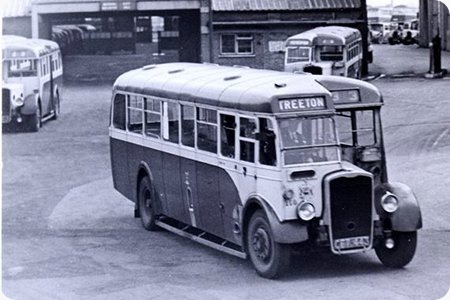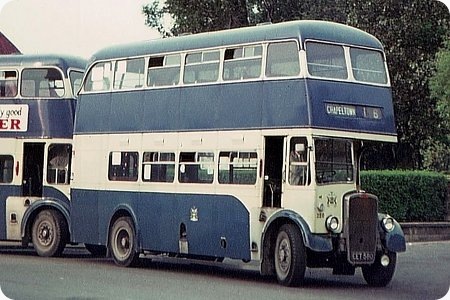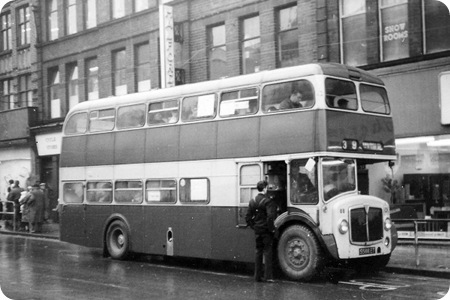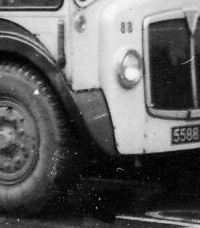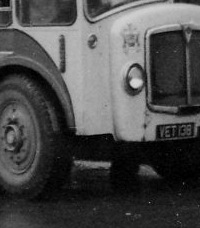Rotherham Corporation – Bristol L5G – CET 443 – 160
Rotherham corporation
1940
Bristol L5G
Bruce B32C
Quite awhile ago we had a posting of a Rotherham Corporation Bristol K6B double decker which was contributed by Ian Wild. The vehicle actually started life in 1949 as a L5B single deck vehicle but after only three years it was rebodied, naturally as comments were made the obvious question came up, what happened to the original saloon bodies?
Thanks to Andrew Charles for sending in the above shot and the following copy:-
The above L5G chassis was built in 1940 and when new carried East Lancs B32C bodywork.
In 1951 the chassis was modernized and rebodied with the two year old body (Bruce on East Lancs frames) from the 1949 L6B which in turn was rebodied as a double decker. An obvious visual indication was that although this chassis was originally built with the high mounted KV radiator – more familiar on JOG type chassis, this vehicle had received on rebuild the later style PV2 radiator with its associated lower bonnet line.
An example of a 1939 L5G still carrying its original radiator can be seen parked behind number 160 and that vehicle had also lost its original East Lancs B32C body. It isn’t possible to identify the specific vehicle shown here but a number of chassis in this batch received new bodies in 1952/3. Built by either Bond (B37R), East Lancs (Bridlington) (B35R) or, in two cases, the Rotherham Corporation Transport bodyshop (B37R) – in all cases they were built on East Lancs frames. In some cases the chassis was lengthened to 29’ prior to receiving the new body.
The vehicle seen to the left of the photo appears to be one of the later L5G of 1950/51, also fitted from new with East Lancs (Bridlington) B32C bodywork.
Rotherham may have got their money out of the 1940 chassis but I am not sure about the 1949 bodies. The withdrawal dates are as follows 159 rebodied again 1956, 162 – 1957, 161 – 1954 and the above vehicle 160 – 1957. At the best the longest surviving body was eight years old when it went for scrap, but the worst is that of 161 at only five years. Another interesting point is that the rest of the batch of L5Gs that kept there original 1940 bodies were withdrawn over the same period 157/8 – 1956, 163/4 – 1957 and 165 – 1954.
Andrew has also put together a Fleet list of Rotherham Corporation Bristol L Types listing all rebodies undertaken. There is a web version here but you will need a wide screen or view at 75%, if you would like an .xls spreadsheet version please contact me in the usual way.
Photograph and Information contributed by Andrew Charles
20/02/11 – 18:42
The postings regarding the Rotherham Bristol conversions from single to double-deck make for most interesting reading. I left Rotherham for Canada many years ago, but have retained a considerable interest in the Corporation fleet of that era, and have collected many photographs over the years over which to reminisce about the "good old days" of Rotherham Corporation buses.
The nine L6B’s that were rebodied as double deckers had been originally bodied by East Lancs (112-4) and Bruce Coachworks (179-184). The three East Lancs bodies were distinguishable from the Bruce examples by having a sliding cab door, whereas the Bruce bodies had a hinged example.
I did some considerable research years ago into the rebodying exercise that went on with respect to these buses, and came to the conclusion that the PSV Circle information is not quite correct as to exactly which L5G’s that originally had Cravens bodies were the recipients of the newer East Lancs/Bruce coachwork. The PSV Circle quotes fleet nos. 137/40/2/3 and 159/60-2/5 as being the nine pre-war and wartime buses that were rebodied. In my collection of Rotherham photographs, I have clear evidence that nos 163 (CET 446) and 168 (CET 564) both received new post-war bodywork in the 1950’s, and am of the opinion that of the buses that the PSV Circle quotes as being rebodied, both 137 and 142 (BET 513/518) actually weren’t rebodied at all, but retained their Cravens structures until withdrawal in 1955, which was considerably earlier than the other seven rebodies. Also, it is worth noting that when 137/42 were eventually withdrawn and sold, the only trace of the pair is of 137 ending up as a showman’s lorry in Montrose, Scotland. 142 disappeared, presumably for scrap, whereas the other seven rebodies, as one would expect, all found further work after being pensioned off by Rotherham, except for 161 (CET 444) which was scrapped prematurely in 11/54 after sustaining accident damage.
Incidentally, of note are 143 and 159, which were two of the rebodied examples. These two actually collided with each other in Rotherham, and both ended up being rebuilt and lengthened and fitted with rear entrance sliding doors, their seating capacity subsequently increased to 37. Remarkably, they both ended up being sold to T.D. Alexander (Greyhound) and ran side by side on contractor’s services in Sheffield, until both ending up in the same Worksop scrapyard together in 1964.
With respect to the reason for the rebodying, one can only assume that when it was decided to operate double-deckers on all routes where practical, apart from rural services to small outlying villages or those routes on which double deck operation was impossible, these nine having six-cylinder engines would have been perfect candidates for rebodying as double deckers, the still relatively new single deck bodies able to be fitted on to older five-cylinder L type chassis that still had several years life left in them but whose original bodies were well past their ‘best by’ date.
I note the comment posted with respect to Rotherham’s only female driver of the era. That would have been Miss Winifred Hallam, whom I believe was the only woman in the country at the time who was licensed to drive trams, trolleybuses and motor buses!! She could indeed handle those Crossleys, and I have a very strong childhood recollection of seeing Miss Hallam being forced to back her Bristol down an icy Doncaster Gate in the town one snowy afternoon, as she was unable to climb the hill due to the severe wintry conditions; seeing the head of curls sticking out of the open cab door as she gingerly inched her way back down on to the flat terrain has been, and likely always will be, an abiding memory!! I hope these comments have been of interest.
Dave Careless
20/02/11 – 20:19
Thanks to Dave for such a comprehensive and interesting feedback.
I would be interested to know if during his research he could clarify a further area regarding the BET xxx chassis that were rebodied with B–R bodies.
The PSV Circle records that I used for the fleet list show specific vehicles of those that were rebodied as having lengthened chassis. Was it genuinely the case that the vehicles included in this exercise were rebuilt with bodies to two different lengths or is the data simply lacking detail in respect of some entries and in fact all were lengthened?
Andrew
21/02/11 – 06:31
What an evocative photograph! Taken at Rotherham’s Rawmarsh Road Depot, the buses are so typically Rotherham. I don’t recall these CET registered buses but remember the very similar post war FET registered ones quite well which must have been amongst the last Bristols supplied to Rotherham. The local independent, Greyhound, mentioned by Dave Careless had a most interesting fleet split between Sheffield and Arbroath, just imagine driving a 5LW engined bus between the two locations! Vehicles were often exchanged between them.
Ian Wild
22/02/11 – 06:22
Thanks for your appreciative comments about the posting, Andrew. With respect to the rebodying of the 1938 L5G’s, 147-55 (BET901-9), and the lengthening exercise that went with it, that all seems a bit vague at best. Apparently the contract for the rebodying of these nine vehicles was awarded to East Lancs at Bridlington, with the bodies being built on steel frames supplied from Blackburn. While the work was in hand, and with four vehicles completed, the decision was taken sometime in 1952 to wind up the Bridlington operation, and according to an article I have in my files, “ …… the vehicle bodies in hand were built in skeleton form and transferred to S.H. Bond of Wythenshawe, Manchester for completion. Wouldn’t they have been a sight to see, being driven from Bridlington to Manchester!!
With respect to the lengthening, I have ‘official’ views of an East Lancs bodied example just completed at Bridlington and a Bond bodied one that looks to be about to set out for Rotherham, and after comparing them carefully, can’t see any noticeable differences, the overhang at the rear looks to be the same in both cases. The only slight difference could possibly be at the front end, where the sloping cab front looks to be slightly more upright on the Bond bodied one, but even that might be a trick of the camera, it’s hard to say.
In yet another article entitled ‘Out of Bond’, published in Transport World for April 1953, there is a write-up on the delivery to Rotherham on February 26th of that year of the first of the five rebodies, in which, and I quote: “The new bodies, which represent the completion of five single-deckers from an order of nine originally placed with East Lancashire Coachbuilders (Bridlington) Ltd., have been mounted on rebuilt 1939 Bristol chassis which originally seated 32 passengers. The chassis rebuilding and modernizing was carried out in the Corporation works and the body design was then modified to take advantage of the new length regulations, so that the vehicles can now seat 35 passengers.”
The PSV Circle Fleet History on Rotherham Corporation lists the five dealt with by Bond as being increased in length and fitted out as B37R, with the four dealt with at Bridlington not being mentioned as lengthened and listed as B35R. It’s hard to imagine that East Lancs would have received an order from Rotherham to rebody nine chassis, but with instructions to only lengthen five of them, these five seating 37 and the four unlengthened ones seating just two less, that would seem pointless. Considering that they both appear to look the same, and with the reference in the ‘Out of Bond’ article referring to the rebodied buses they completed as being 35 seaters, if I were a betting man I’d say that all nine were lengthened, and their revised seating capacity was 35, despite what it says in the PSV Circle Fleet History. I recall reading somewhere that the sliding rear doors on these rebodies proved troublesome, the severe overhang of the body caused some slight distortion and some of the conducting staff found the doors quite difficult to open and close. Hopefully there might be somebody out there who can confirm beyond reasonable doubt the seating capacity of all nine of these rebodied machines.
For the record, these lengthened saloons were quite often to be found on the Sheffield – Rotherham – Doncaster service, route 77, until the route was revised to clear a low bridge at the Sheffield end in 1956, and became the preserve of a batch of seven Weymann bodied Daimler CVG6’s that lasted on there for years. The BET-saloons ended their days on school journeys and colliery extras, and six of them were withdrawn in late 1957 following the delivery of an equal number of AEC Reliances, Rotherham’s first underfloor engined single-deckers. Hope this is of interest.
Dave Careless
12/06/15 – 06:07
Just found out a titbit about Bruce. They were originally called Air Dispatch (Coachbuilders) Ltd. in Cardiff, but were renamed Bruce Coach Works in September 1948. They seemed to consistently build bodies on East Lancs frames.
Chris Hebbron
Quick links to the - Comments Page - Contact Page - Home Page
